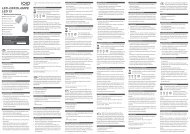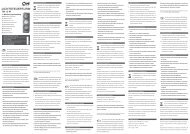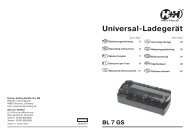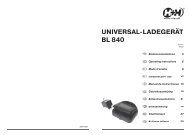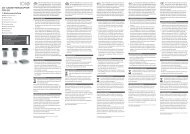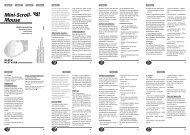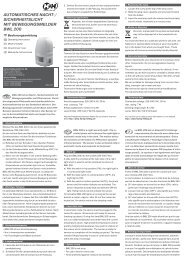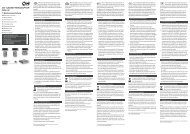VM 52 D, Bed.-A (Konvertiert)-5 - Hartig + Helling GmbH & Co. KG
VM 52 D, Bed.-A (Konvertiert)-5 - Hartig + Helling GmbH & Co. KG
VM 52 D, Bed.-A (Konvertiert)-5 - Hartig + Helling GmbH & Co. KG
Erfolgreiche ePaper selbst erstellen
Machen Sie aus Ihren PDF Publikationen ein blätterbares Flipbook mit unserer einzigartigen Google optimierten e-Paper Software.
• Push the test lines into the unit<br />
as far as they will go.<br />
• Do not subject the unit to<br />
substantial fluctuations in<br />
temperature, otherwise this<br />
may affect the measurement<br />
results.<br />
• If you find that the unit or<br />
measuring lines are damaged,<br />
stop using the unit and have it<br />
checked by authorised<br />
personnel.<br />
• Never use the unit to perform<br />
measurements where the<br />
voltage exceeds 600V referred<br />
to ground potential<br />
(category III 600 V).<br />
• Once the measurements have<br />
been completed, switch the<br />
measuring range selector to<br />
“OFF”. This ensures the unit<br />
remains ready for operation in<br />
the future and prolongs the<br />
service life of your batteries.<br />
Measuring alternating<br />
voltages<br />
Test circuit:<br />
U~ <strong>VM</strong> <strong>52</strong> D<br />
1. <strong>Co</strong>nnect the black test lead to<br />
the ground jack “COM”.<br />
2. <strong>Co</strong>nnect the red test lead to jack<br />
“V/Ω”.<br />
3. Set the measuring range selector<br />
to the “V~” range and select a<br />
measuring range which<br />
corresponds to the maximum<br />
anticipated AC voltage.<br />
4. <strong>Co</strong>nnect the test lines to the test<br />
circuit.<br />
5. Switch on the test circuit if<br />
necessary.<br />
Read the measurement from the<br />
display.<br />
Maximum input voltage 750 V AC<br />
at 40-1000 Hz!<br />
Measuring direct voltages<br />
Test circuit:<br />
U= <strong>VM</strong> <strong>52</strong> D<br />
1. <strong>Co</strong>nnect the black test lead to<br />
the ground jack “COM”.<br />
2. <strong>Co</strong>nnect the red test lead to jack<br />
“V/Ω”.<br />
3. Set the measuring range selector<br />
to the “V ” range and select a<br />
measuring range which<br />
corresponds to the maximum<br />
anticipated DC voltage.<br />
4. <strong>Co</strong>nnect the test lines to the test<br />
circuit. Ensure the correct<br />
polarity of the test heads (+/-).<br />
5. Switch on the test circuit if<br />
necessary.<br />
Read the measurement from the<br />
display.<br />
If a minus sign appears in front of<br />
the measured value, the polarity<br />
of the test heads is wrong.<br />
If necessary, switch off the test<br />
circuit and then re-connect the test<br />
heads to the latter.<br />
Maximum input voltage<br />
1000 V DC!<br />
Measuring direct currents<br />
Test circuit:<br />
1. <strong>Co</strong>nnect the black test lead to<br />
the ground jack “COM”.<br />
U= <strong>VM</strong> <strong>52</strong> D<br />
load, e. g.<br />
incandescent lamp<br />
2. <strong>Co</strong>nnect the red test lead to jack<br />
“VΩmA” if the maximum<br />
anticipated current is 200 mA.<br />
Otherwise use jack “10 A”.<br />
3. Set the measuring range selector<br />
to the “A ” range and select a<br />
measuring range which<br />
corresponds to the maximum<br />
anticipated DC current. If you do<br />
not know this, select the highest<br />
value.<br />
When using jack “10 A”, set the<br />
measuring range selector to<br />
range “20 m 10 A”.4. Disconnect<br />
the test circuit and switch the<br />
test instrument in series with<br />
the test load (consumer).<br />
12<br />
13




